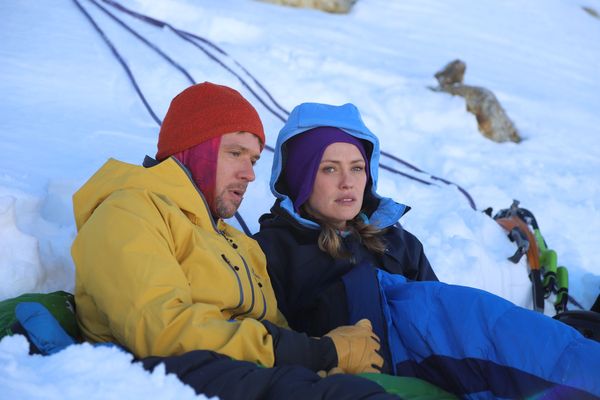 |
| Ryan Phillippe and Hannah New in Summit Fever Photo: Signature Entertainment |
To some people, mountains are impossibly remote places, the home of gods; to others, they are a sheltering bulwark against the worst of the weather. To still others, they are a challenge, their very existence inspiring an insatiable desire to get to the top. Michael (Freddie Thorp) had taken a break from climbing after the death of his sister, but is persuaded to return by the opportunity to take on three famous Alpine peaks: the Matterhorn, the Eiger and Mont Blanc. In the process he is drawn into a group of climbers who share his passion to varying degrees, not all of whom know where the edge is. Summit Fever is a film which traverses familiar territory by a route of its own making. When I met director Julian Gilbey, I asked him how it related to his own passion for the sport.
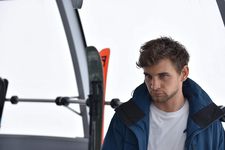 |
| Freddie Thorp in Summit Fever Photo: Signature Entertainment |
“I've been climbing since the mid 2000s,”he says, “and yeah, that was my whole inspiration really. I've been climbing since before I made A Lonely Place To Die, and I wanted to shoehorn it in there. But whereas in that film it's more of a circumstantial group of climbers, you know, and then they have to use some of their skills to outwit the enemy, this film was far more about the climbing culture, mountaineering culture, specifically in the French Alps and Chamonix, that kind of area, which I'm familiar with.”
There are a few snide remarks made in the film about the mountains of Scotland and Wales, and when I mention this he’s quick to stress that they don’t reflect his own sentiments.
“I'm going to be winter mountaineering on the Isle of Skye this winter, to do a winter traverse of the Cuillin Ridge. Some of the most brutal – not necessarily the highest, but some of the toughest mountains – are in Scotland and Wales and Northern England. They have some of the toughest, most beautiful mountains in the world. Yes, they don't necessarily have the same altitude, but my God, they cause you enough problems. Ryan [Phillippe]'s character was just, he had to start off being a bit flippant. It's like when you meet someone, and they're testing the waters. And sure enough, they become friends. But yeah, I thought, ‘You know what, we'll start him off as a bit of a dick.’ And if you're going to call them molehills in Scotland and Wales, yeah, it's a dickhead thing to say, but we warm to him because he becomes less of a dick.”
The first thing that I thought of when I heard that remark, I tell him, is that people still die on those mountains. And people die on several occasions in this film. A lot of it is about how people cope with that. But something I like is the way he sets up characters who talk frequently about other climbers doing irresponsible things, reassure themselves that they’re not like that, and then do a different set of irresponsible things.
“Well, firstly, you certainly don't need to fall 6,000 feet off the north face of the Eiger. You can quite happily fall 15 feet of any rock face, and fall onto rock, and that will do the same thing,” he says. “Yeah, it's an interesting one, because there are a lot of things that happen in the film that people people are so sure of one thing, you know, if you've got a rope, and you've got this, you'll be fine. As long as you don't do this type of thing, you know? And that's not really the case. Because you have objective dangers on the mountains like avalanches, rock fall or electrical storms. That's the other thing. Storms roll in. And all of a sudden, you're on a giant lightning conductor.”
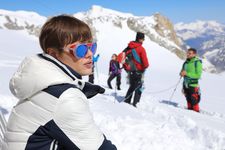 |
| Mathilde Warnier in Summit Fever Photo: Signature Entertainment |
He tells me about a mountaintop statue of the Virgin Mary which had to be replaced in 2004 because it had been struck by lightning so many times that it had melted. This does not, however, reduce the attraction of climbing.
“The thing is, it's such a beautiful, pure sport. But having said that, in five years – because we started going out filming this film in 2017. Admittedly, we didn't use actors until 2018. The point I'm coming round to here is that in the time that we've been out there shooting, there have always been people being killed. And you know, there were four people killed on the Monday and Tuesday we were filming on last May. They were all killed an avalanche because there was fresh snow and Jake Holland, the third unit director, he was doing some recce’ing to do some skiing down the down the north side of the Aiguille du Midi, and he saw a skier get completely covered by an avalanche and, you know, he had to dig out somebody who'd been killed in an avalanche. And 48 hours later, he's there working with us.
“The first time we ever meet Isabelle, you see this incredible ski to a halt, where she swishes up to a halt. And I'll let you into a secret. That is not Mathilde Warnier. That is Winter Olympics double gold medallist Adèle Milloz, who came on board to do third unit footage right at the end of filming. And she sadly was killed the other day, on the 12th of August, climbing the Aiguille du Peigne with a 30 year old climbing partner. They got killed and they found the bodies and they don't actually know exactly what happened. It was incredibly tragic. Nobody actually got injured on our film. But the fact that somebody who worked on our film has since been killed is, firstly, a complete tragedy, it really upsets me. But secondly, it just goes to show the reality of this place.
“I think somebody mentioned about the Eiger, it's a very public place to die. You know, you’ve got people sitting drinking a gin and tonic or some wine or cappuccino, you can look up at the face with a telescope. It's not like being out in the middle of nowhere, like, you know, in Peru and on Sila Grande or on K2 where you can't see any built up areas for 150 kilometres. It's all the more dangerous because it's a little more accessible.”
I ask how his team coordinated shooting in order to be climbing at the safest times.
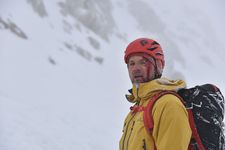 |
| Ryan Phillippe in Summit Fever Photo: Signature Entertainment |
“We had to shoot at different times of year for different peaks,” he explains, “although it's set in early summer and whatever. But in the reality is that we can't go up the Eiger in May and June, it's too dangerous. So we filmed on the Eiger in November, and we filmed on the Eiger in April, because you need the weather to be colder. Freddie and myself climbed the Matterhorn with two IFMGA guides in September 2018, because we were matching some aerial footage we shot the year before. You actually have to shoot lots of different things at different times. But ski wise, and especially in 2021, you can ski all year round at that altitude.
“The Chamonix glacier is 3,800 metres, it's 12,000 feet, you know? It's very, very high. And it's year round snow and rock and ice. When we were there at the end of May, it was so much snow we were wading through it. So yeah, we always had to think what was the safest time of year we could shoot certain sections, but I'm afraid there's just no guarantees of it. We had so much snow last year, which created a lot of avalanches, you know, which in itself is very dangerous.”
How did they work around the fact that those slopes are really popular and frequently full of people?
“That's an interesting point. The Matterhorn can be a notoriously overcrowded mountain. I climbed it twice in 2011 and 2018, and both times it's been not very many people at all, but actually in in 2018, we were trying to go up and I'd already thought, ‘Well, if there are a lot of other people, we might have to digitally take them off.’ And what happened was we actually climbed the Matterhorn one and a half times for this film. Because you know, Freddie and myself and two guides, John and Danny, we went off at four o'clock the first morning and the weather forecast was perfect, and then out of nowhere this shitstorm hit. And it was just terrible and sharp.
“It was a blessing in disguise because I hadn't acclimatised. I'd been running like a mountain goat up similar terrain two weeks earlier in in Snowdonia, but here on the Matterhorn I was gasping, because couldn't get the oxygen in and I’d had a bad night's sleep. I hadn't had enough time to acclimate. And anyway, it was pouring the rain, and there must have been 150 people on the mountain, it was crowded. What happened was the shit weather came in. At eight, nine o'clock that night, the weather got good again. And everyone had gone. There was us and I think about eight or ten other people climbing. They went off ahead. We had the entire mountain, the entire summit and everything to ourselves. It was incredible.
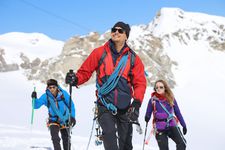 |
| Michel Biel in Summit Fever Photo: Signature Entertainment |
“The Eiger was different. Nobody would have had access to where we were, so we had that completely deserted to ourselves, you know, in parts. And then funnily enough last year, in the pandemic, Mont Blanc was completely closed to everybody except us. Suddenly it looked deserted and utterly beautiful and incredible.”
Freddie works really well as an actor, but he's got to be able to handle the physical side of it as well. Where did Julian find him?
“I didn’t have a plan,” he says. “It was only because of Freddie's attitude and ability that I turned to my producer, Tiernan, and I went, ‘You know what, this coming September? Get me to go out with Freddie. I think we can get him up the Matterhorn.”
Tiernan was sceptical, he says, pointing out that they had already captured good footage with stunt doubles, but he persisted.
“I said, ‘Yeah, but wouldn’t it be really cool if you really see Freddie with the Matterhorn behind him?’ And I said, ‘Look, I'll make sure that I say it in every interview.’ And he's like, ‘Can it really be done?’ And I spoke to Freddy about it, and Freddy was totally up for it. He's very young. He's very fit. He's in really good shape. And he worked with some of the most incredible climbers. We did some incredible climbing just to prep for the Matterhorn. We shot Freddie on the north face of the Eiger. I mean, you can put Freddie anywhere.
“By the time we were filming with the main unit last April in May, I had already shot with him for two years prior. I remember one of the IFMGA guides went ‘He's not just an actor, he's a mountaineer.’ And I thought, that's a big fucking compliment. And Freddie deserves that 100%. I mean, the attitude he put into it, you know, and I think he also really enjoyed playing a likeable character. I think he's adorable.
We hired some of the world's best climbers, the most experienced people, and they were able to take us to all sorts of places. We were able to use the Skyway, which is one of the second highest cable cars in the world, which took us up to 11,500 feet. My attitude was, you know, every time I was going to shoot somebody from the side, I’ve got a panorama that would make David Lean proud. You know what I mean? I've got Mont Blanc behind you there or I can have Italy behind you there. It has kind of be spectacular.
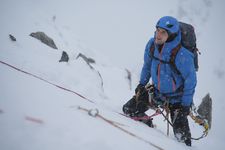 |
| Freddie Thorp in Summit Fever Photo: Signature Entertainment |
“But yeah. Ryan Philippe, he was very, very keen to do it properly. So we had him exclusively attached to one of the guides, a brilliant, brilliant young English climber called Will. And Will took him ice climbing, took him rock climbing, took him everywhere. And you know, Ryan loved it, because he's done a million films and television shows, you know? He can strip an M16 weapon down and blah, blah, blah, and all the rest of it. But he was a beginner at climbing and I think he wanted to kind of bring that air of expertise and make that convincing. Everyone was really up for it and we made sure that everyone was safe as houses.”
Most climbing films create tension based around the risk of falling, but there are a great many more hazards brought to light in this one. Some of them, it emerges, stem from personal experience.
“Something happened to me in Switzerland in 2011,” he says. “I was on a rock climb called Aguille d’Argentiere. It's a huge slab massif, five or six hundred metres, and it actually starts off steeper than it finishes, so it actually gets easier. And I remember, I was with this wonderful northern Irishman called Dave Hollinger, who worked on A Lonely Place To Die. And I was climbing with him. And I was on my first climb in Switzerland for sort of a 12 day adventure. And somebody knocked a rock the size of a suitcase and it came hurtling down. I heard it go bang, bang, bang. And I literally managed to duck under a shelf of rock. I pushed myself right into the side of the rock, and this thing fell past me no more than a metre. And I was so shaken by this, I said ‘Dave, I can't have 12 days of this, man. This is insane.’ He goes, ‘No, that's not all that common.’
“I thought, you know, you could be at the bottom of the climb and still be killed. It's an interesting thing. Why do climbers wear helmets? I can tell you for free that if you fall 6,000 feet off the Eiger the helmet isn't going to help you. You're going to die. That helmet is for rocks and stones and all sorts of ice and stuff coming from above you.
“I remember another time, in 2011. We were coming down from Mont Blanc du Tacul, and there were these huge seracs, these giant ice walls that that can collapse, compacted snow and ice. A lot of people have been killed, in 2008 and a couple of years after I was there as well. And I remember Dave saying ‘Okay, Julian, we're going to walk down under these seracs here. We’ve just got to do it really, really quickly because they're unstable. Don't talk now.’ And I realised we're taking a risk going under something that has killed many, many people and two years later, you know, a bunch of people got killed there as well. And that's where rock climbing and mountaineering blurs because with mountaineering you cannot cut out the objective dangers. There is no objectively safe route up Mont Blanc. So mountaineering, there's a lot more judgement about weather and the skills to judge when something isn't safe. And even then you can't always get it right, but it's such a beautiful, wonderful, brilliant thing to do. There are so many days that go wonderfully and perfectly that you know, you want to keep doing it.
 |
| Summit Fever poster Photo: Signature Entertainment |
“This is not a film that’s just for for young people. It’s a film for anyone who was ever young and anyone who was ever a bit a bit braver and a bit more foolish than perhaps we are as we get a wee bit older. It's about that lust for adventure. There are some people out there, myself included, who look up at a mountain and go ‘God, I’d really like to get up there.’ You know, I found myself watching the Lord Of The Rings, and they’re charging along and I'm looking at this route with this mountain behind them all, and I’m looking at some New Zealand maps.” He laughs
“What can people take away from this movie? I want people to take away anything and everything. It's about all aspects of life, about balancing, risk versus reward. It's about growing up, it's about a baptism of fire. You know, at the start of the film, he [Freddie’s character, then in England] says, ‘I'm just going to do this job, it's just going to be temporary.’ Yeah, well, you know what? Everyone says they're going to do a temporary job and then do something they really want to do. And what happens is the job ends up being temporary for 50 years, because your boss is like, ‘How much do I have to pay you to put your ambitions and your life on hold? I'll increase your pay every year, and I'll give you security. ‘ You know what is it they say: the route to success and achievement is paved by plenty of very comfortable parking places along the way.
“This film is about when you just have that fearlessness, that immortality of youth. And I think by the end of the film, we come to terms with the fact that we are not immortal. I'm not going to ruin the end of the film, but just because he seems to be doing something that's utterly crazy, to him it's achievable. And it goes against what other characters were saying, but yeah. Some people will always go to that edge and that extreme.”
Signature Entertainment presents Summit Fever on digital platforms on 17 October





















